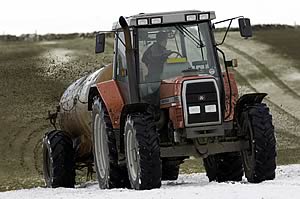17/11/08
Fertiliser cost inflation in the region of 170 per cent over 2008 has forced an 18-20 per cent rise in the overall cost of running a typical beef farm.
And, says the National Beef Association, because fertiliser prices are expected to stick, or even increase, right through to 2012 it is important that a more informed approach to routine soil, sward, and fertiliser management becomes a priority throughout the beef sector.
This means individual farmers working now to put together their most cost effective spring fertiliser order by soil testing as many important fields as possible, checking for, and then breaking, compaction in new silage leys, and also spreading lime if necessary.
“If someone just gives up on fertiliser, and decides not to buy any, because they think it is too expensive they may not have enough grass for their stock in as little as a year’s time,” warned NBA director, Kim Haywood.
“But they can still slash their fertiliser costs if they spend more time on soil and sward management and make best use of the phosphate and potash already left by their cattle either on pasture itself or in the slurry pit and muck midden.”
The NBA, which has spoken to several grassland management specialists over the last three months, agrees that great deal of compound fertiliser has been wasted in the past because both soil and sward condition were too poor to allow full uptake.
“The impact of many nitrogen applications was lost because pH was too low and the sub-standard sward was too meagre to make use of it,” said Ms Haywood, “and at the same time phosphate and potash was wasted when applied to well stocked pastures which only needed a dressing of pure nitrogen.”
“Beef farmers looking at N costing around £1.04 a kilo, P at about £1.50 and K at 80-85p might be frightened by the size of the bill but it is important to realise that if fertiliser on grassland is properly used it is still significantly more cost effective than buying in feed.”
“A soil index of 2-3 on pasture and a pH that is over 6-6.5 will quickly save thousands of pounds so it is worth taking the trouble to get these checked out before spring.”
“Good use of clover can cut nitrogen bills even further - perhaps by as much as £130 per ha on a properly established pasture that is well stocked and managed.”
“And no one should forget the value of manure and slurry. If these are applied to fields that need them their worth can be as high as £120-£300 per hectare and the value of cattle slurry produced across the UK has been estimated to be about £275 million in fertiliser substitute terms,” Ms Haywood added.
 Make the Most of Organic Nutrients Make the Most of Organic Nutrients
 Spring Oilseed Rape Tops the Charts Spring Oilseed Rape Tops the Charts
 Bacteria Manage Perfume Oil Production from Vetiver Grass Bacteria Manage Perfume Oil Production from Vetiver Grass
|



